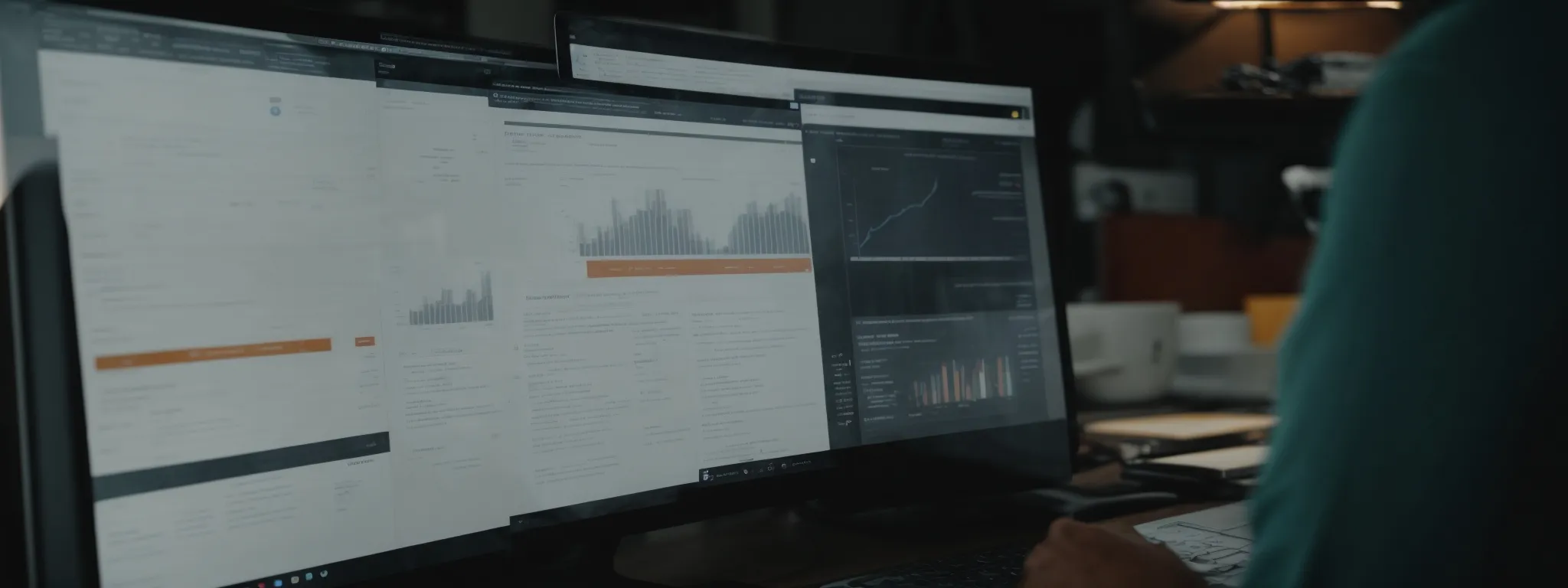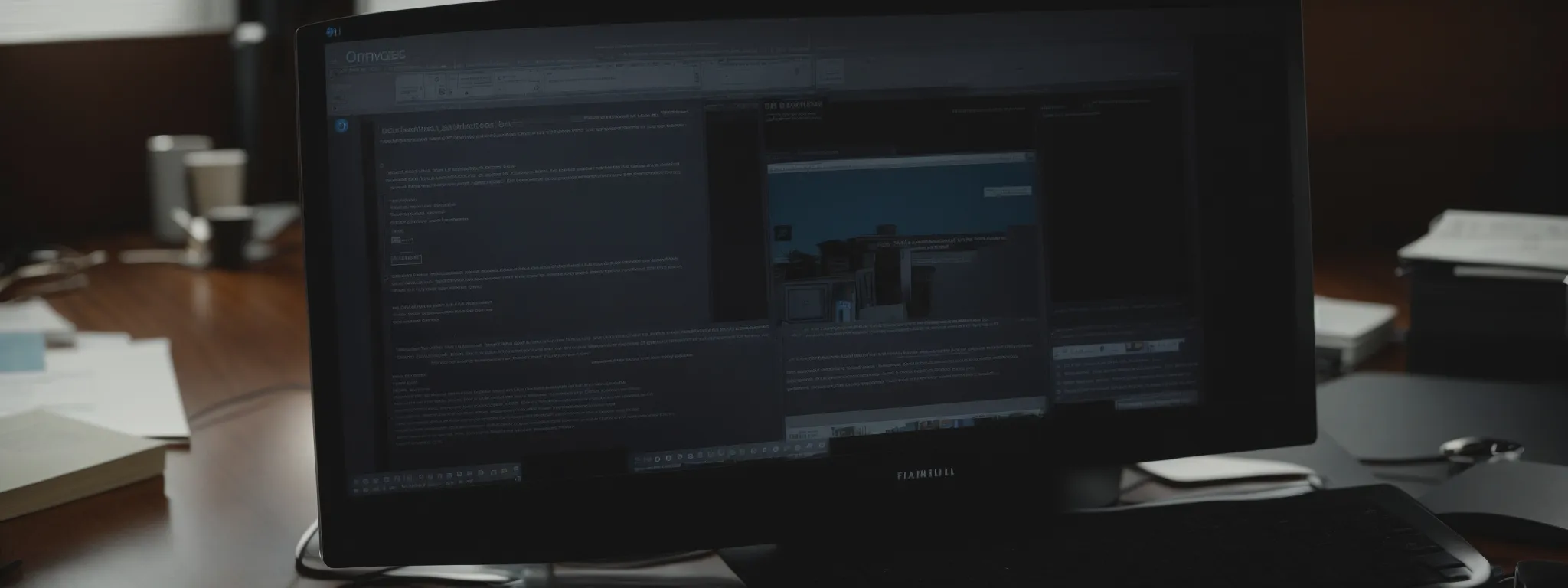On-Page SEO Essentials
On-Page SEO Essentials: Key Strategies for Optimizing Your Site On-page SEO forms the cornerstone of any successful digital marketing strategy, enabling businesses to optimize their web presence […]
On-Page SEO Essentials: Key Strategies for Optimizing Your Site
On-page SEO forms the cornerstone of any successful digital marketing strategy, enabling businesses to optimize their web presence for both search engines and users.
By mastering on-page elements such as content quality, HTML tags, structure, visual enhancements, and user experience, companies can significantly improve their site’s relevance and authority.
LinkGraph’s SEO services expertly guide brands through the intricate process of crafting content that resonates with readers while satisfying search algorithm criteria.
Tailored tactics not only foster increased organic traffic but also bolster site engagement, a vital metric in today’s competitive online landscape.
Keep reading to uncover the pivotal techniques involved in honing on-page SEO and how LinkGraph elevates this practice to a fine art.
Key Takeaways
- On-Page SEO Surpasses Simple Keyword Use, Focusing on a Site’s Content and Structure for Search Relevancy
- LinkGraph Merges on-Page SEO With Broader Strategies for a Cohesive Digital Presence
- Effective on-Page SEO Requires Skillful Integration of HTML Tags for Clear Structure and Search Engine Visibility
- Optimizing Images Is Critical for Site Speed and User Experience, Both Key Factors in SEO
- LinkGraph’s on-Page SEO Services Aim to Create a Seamless User Experience Through Intuitive Site Navigation and Fast Page Loading Times
Understanding the Fundamentals of on-Page SEO

Embarking on the journey of on-page SEO, where strategic manipulation of page elements to appeal to search engines is paramount, one must first delineate its perimeters.
On-page SEO, transcending mere keyword insertion, encompasses HTML tags, headers, images, and a host of other elements within the source code that collectively work to enhance page visibility and user engagement.
Not operating in isolation, these practices nest within a more capacious SEO strategy, drawing upon the synergy of off-page initiatives and technical SEO to forge a robust digital presence.
This essential component asserts its significance by tethering the user’s search intent to the page content, thereby reinforcing the website’s relevance and authority in search engine rankings.
The Definition and Scope of on-Page SEO
On-page SEO is a meticulous craft, where Experts Like Those From LinkGraph employ a tapestry of sophisticated techniques to amplify a site’s favor with search engines. These tactics include optimizing the page title, meta description, header tags, and ensuring images bear relevant alt text to boost accessibility and relevance.
Central to on-page strategies is the need for Well-Structured, Compelling Content that resonates with both search engines and users. Focusing on on-page SEO services, LinkGraph aids its clients in achieving the delicate balance of user experience and search engine requirements, essential for establishing search authority and driving organic traffic.
How on-Page SEO Fits Into the Broader SEO Strategy
On-page SEO interlocks with the expansive landscape of a total SEO strategy, serving as the bedrock upon which broader initiatives build. It deals directly with the content and architecture of a website, optimizing each page to ensure maximum relevancy and digestibility for users and search engines alike.
The alignment of on-page tactics with off-page efforts such as white-label link building and social media engagement forms a cohesive SEO campaign. Elements such as site speed, responsiveness, and interlinking content are scrutinized to enrich the user journey from the moment they enter a search query:
- Site architecture is meticulously mapped to reinforce the cohesive flow of navigation and content discovery.
- Internal linking is strategized to guide visitors intuitively, promoting extended interaction with the site.
- User experience is prioritized, ensuring that responsive design and fast page load times are in place to reduce bounce rates.
LinkGraph stands at the forefront of these efforts, Integrating Their on-Page SEO Services seamlessly into comprehensive ranking guides and crafting content for SEO that propels brands to the top of search engine results pages, while never losing sight of the end user’s needs.
Crafting High-Quality Content for Users and Search Engines

In the realm of on-page SEO, the creation of high-quality content stands as a linchpin, bridging the gap between a brand’s message and the algorithmic intricacies of search engines.
As LinkGraph’s team deftly navigates this intricate space, they emphasize both the innate value of content and its relevance to reader interest.
Skilled in weaving together seamless narratives with strategic keyword usage, they aim to strike a balance that serves the dual purpose of engaging the reader and satisfying search engine standards for readability and relevance.
This nuanced approach prioritizes a user-centric model while maintaining the technical precision required for search engine recognition.
Prioritizing Valuable and Relevant Content
In the pursuit of refining on-page SEO, LinkGraph unequivocally recognizes the imperativeness of content that furnishes value alongside meeting search intent. With an unswerving focus, they curate material that not only furnishes readers with insightful information but also aligns meticulously with the nuanced demands of search algorithms.
Each keystroke and sentence is sculpted with precision, ensuring that the resulting content stands as a testament to the brand’s expertise and the user’s quest for answers. LinkGraph meticulously infuses relevance into every paragraph, upholding the essence of meaningful and authoritative content as a cardinal rule within on-page SEO practices.
Balancing Keyword Use With Readability
Adeptly harmonizing the density of keywords with the natural flow of prose poses a unique challenge in on-page SEO, one that specialists at LinkGraph navigate with expertise. The insertion of target phrases must never encumber the narrative, but rather blend seamlessly, maintaining clarity and eloquence in equal measure.
LinkGraph’s seasoned authors, through their SEO content strategy, accomplish this equilibrium by threading keywords into the fabric of the text with judicious precision. Emphasizing the narrative’s continuity, they ensure the reader’s journey through the content remains unblemished by overt optimization techniques, reinforcing the enjoyment and comprehension of the material presented.
Leveraging HTML Tags to Enhance SEO

In the intricate dance of on-page SEO, skilful manipulation of HTML elements plays a pivotal role in capturing and maintaining the search engine’s gaze.
Title tags and meta descriptions serve as the first point of contact between a website and a potential visitor, setting the stage for the user’s experience and ushering them from the search engine results pages (SERPs) into the site’s carefully crafted landscape.
LinkGraph’s acumen in optimizing these content elements transforms them from mere code snippets into powerful tools, hypnotizing searchers with compelling narratives and fostering heightened click-through rates.
Utilizing Title Tags to Capture Attention
In the competitive echelon of search engine rankings, title tags emerge as subtle yet potent heralds of a web page’s content. Masterfully Crafted by the Professionals at LinkGraph, title tags are engineered not only to resonate with the target audience but also to conform to the essence of SEO best practices.
Title tags hold the formidable task of encapsulating the central theme of a web page while sparking the curiosity of the searcher, compelling them to click. As search engines weigh the relevancy of title tags heavily in the algorithmic balance, LinkGraph’s expertise in striking an optimal equilibrium between succinct appeal and keyword integration is paramount:
| SEO Element | Role in SEO | LinkGraph’s Strategy |
|---|---|---|
| Title Tag | Headlining web page content in SERPs | Combines keyword use and compelling language to maximize CTR |
| Meta Description | Supplements the title tag with concise summaries | Utilizes actionable language and value proposition to entice clicks |
| Header Tags (H1, H2, etc.) | Structuring content for both usability and keyword emphasis | Implements hierarchical relevance and keyword-rich headings |
Crafting Meta Descriptions That Drive Click-Through Rates
Meta descriptions act as concise summaries enticing users to click through from the search engine results pages to a website. Meticulously Composed by LinkGraph, these snippets distill the essence of a webpage’s content, converging persuasive language with a clear value proposition, to ignite the searcher’s interest.
Efficiently maximizing click-through rates requires meta descriptions that combine strategic keyword placement with a compelling call to action. By shaping these descriptions to serve as an extension of the page title, LinkGraph skillfully encourages user engagement, further optimizing the web page’s performance:
- LinkGraph formulates meta descriptions that echo the content’s core benefits, prompting immediate interaction.
- The company’s precise use of language in this space persuasively guides the user from the SERPs to the website.
- Through data-driven insights, LinkGraph refines these descriptions to align with evolving search trends and user behaviors.
Utilizing Headings to Structure Content Effectively

In the sophisticated realm of on-page SEO, effective utilization of HTML headings is paramount for constructing a clear and organized structure that both search engines and users can navigate with ease.
Headers serve to delineate thematic boundaries, with the H1 tag heralding the primary focus of the page and the subsequent H2 and H3 tags articulating a hierarchical arrangement of topics.
Employing these tags not only enhances readability by breaking down text into digestible sections but also underpins key on-page SEO elements that signal content relevance to search engines, optimizing for better search visibility and user experience.
Implementing an H1 Tag for Each Page
When it comes to on-page SEO, the H1 tag occupies a critical role in delineating the central topic of a webpage. A solitary, strategically honed H1 tag, crafted prominently by LinkGraph’s adept SEO professionals, acts as a beacon to search engines, signifying the primary subject matter and keywords around which the content orbits.
Ensuring that each page possesses a Unique H1 Tag is a touchstone of LinkGraph’s on-page optimization services. This singularity in headings paves the way for clearer thematic distinction and aids search engines in understanding the page’s purpose and content hierarchy:
- Each H1 tag encapsulates the essential message of the page, enhancing topical relevance.
- Carefully selected keywords within the H1 tag boost the page’s visibility for targeted search queries.
- The distinctive H1 streamlines user navigation, underscoring the webpage’s focus for improved reader retention.
Using H2 and H3 Tags to Organize Page Hierarchy
In the landscape of on-page SEO, the Intelligent Use of H2 and H3 Tags is instrumental for introducing order and clarity within web page content. These tags act as signposts, delineating subtopics and guiding the reader through the narrative landscape of the page: reinforcing the flow and supporting the reader’s exploration of the material.
- H2 tags herald secondary subjects, branching from the main theme signaled by the H1.
- H3 tags further granulate content, delineating nuanced points under the H2 umbrella.
- Logical sequencing of H2 and H3 tags forms a clear, discernible content hierarchy for users and search engines.
LinkGraph maximizes the efficacy of H2 and H3 tags by orchestrating them in a harmonious hierarchy that amplifies the webpage’s thematic architecture. This structured approach not only aids users in identifying relevant sections swiftly but also enhances the content’s navigability, a vital SEO qualifier for search engine algorithms.
Boosting on-Page SEO With Visual Elements

Embracing the indispensable role of visual elements in on-page SEO necessitates a nuanced approach that goes beyond mere aesthetics.
In the multifaceted digital landscape, images are not only visual stimulants but also pivotal SEO assets that, when optimized correctly, can significantly enhance site performance and user experience.
They are integral to maintaining site speed, a factor that search engines prioritize for enhancing user satisfaction.
LinkGraph’s on-page SEO services provide meticulous attention to optimizing images for faster loading and leveraging alt text, ensuring that visual content contributes positively to a site’s search engine optimization efforts while enriching the user’s encounter with the brand’s digital persona.
Optimizing Images for Faster Loading
Within the scope of on-page SEO, image optimization for faster page loading is an exercise in Balancing Visual Quality and Performance. LinkGraph advocates for the compression of images to ensure they are not a hindrance to page speed, a critical metric that impacts both user experience and search engine rankings.
Properly optimized images can noticeably reduce load times, reinforcing the seamless experience a user has with a given webpage. The precise reduction of file sizes without compromising visual fidelity is a task that LinkGraph undertakes with astute attention, ensuring swift page content rendering:
- Lossless compression techniques are applied to images to decrease file size while maintaining quality.
- Adaptive sizing methods are used to serve appropriately scaled images based on the user’s device.
- LinkGraph implements caching policies for images to facilitate faster subsequent load times.
Using Alt Text to Improve Image Context
Alt text embodies an essential element of on-page SEO, enriching image context for search engines that crawl and index a website’s visual content. By succinctly describing the visual and functional purpose of an image, alt text ensures that images contribute to the overall SEO value of the site, even when they’re not directly viewable by the user.
This practice not only reinforces accessibility for users who rely on screen readers but also provides search engines with valuable information to understand the content’s context and relevance. Accurate and keyword-sensitive Alt Text Descriptions enhance the likelihood of images appearing in image search results, thus expanding a site’s search visibility:
- Alt text serves as an SEO relevancy signal, connecting images with user search queries.
- It assists in delivering a semantically rich narrative that complements the surrounding text content.
- Through descriptive alt text, LinkGraph ensures that all visual assets add interpretive value to the web page.
Improving User Experience and on-Page Time

In an era where the digital realm has become synonymous with instant gratification, improving user experience is not just a goal—it is a necessity.
A crucial element of on-page SEO, and perhaps the most impactful on a site’s retention ability, is the optimization of user interaction with the website.
This entails refining site navigation to ensure intuitive usability and augmenting page speed for an undeniably smooth user experience.
By focusing on these facets, businesses prioritize the needs of their audience, laying a foundation for extended on-page time and fostering a positive perception of their brand.
Enhancing Site Navigation for Better Usability
LinkGraph’s proficiency in on-page SEO extends to the delicate art of Streamlining Site Navigation, thus facilitating a user-friendly and intuitive interface. Their strategic design prioritizes logical flow and ease of access to various sections of the website, ensuring a frictionless transition for users as they seek information.
Recognizing the importance of first impressions, LinkGraph leverages their expertise to assess and refine navigational elements, effectively reducing the time it takes for users to find what they are searching for. This approach amplifies user engagement and contributes to a notable increase in on-page time—an undisputed indicator of a site’s resonance with its audience.
Increasing Page Speed for a Smoother Experience
Addressing Page Speed is a critical facet of LinkGraph’s on-page SEO services, as this factor significantly influences both search engine rankings and user satisfaction. By expediting content delivery, websites cater to the modern user’s expectation for prompt, efficient browsing experiences: a key determinant in retaining visitor attention and encouraging deeper site engagement.
- Focus on optimizing server response times to provide a swift initial website access point.
- Employ content delivery networks (CDNs) to reduce latency and accelerate asset delivery.
- Optimize coding and leverage browser caching to enhance retrieval of recurring page elements.
Fine-tuning the elements that contribute to page loading times, LinkGraph helps clients cultivate a sleek, responsive online presence. This concentration on speed optimization reflects a committed effort to support a brand’s imperative to offer a seamless user interface free from delays that drive visitors away and diminish search engine ranking potentials.
Conclusion
In conclusion, mastering on-page SEO is crucial for elevating a website’s visibility and enhancing user engagement.
Techniques that optimize title tags, meta descriptions, and headings are vital for capturing the attention of both users and search engines.
High-quality content balanced with strategic keyword use ensures relevance and readability, while optimizing visual elements like images with alt text improves context and page speed.
Seamless site navigation and fast page load times are key to providing a superior user experience, which encourages extended on-page time and user retention.
Each on-page element must be meticulously crafted, as it forms the bedrock of a robust SEO strategy that aligns with broader initiatives to drive organic traffic and strengthen a website’s search authority.














































































